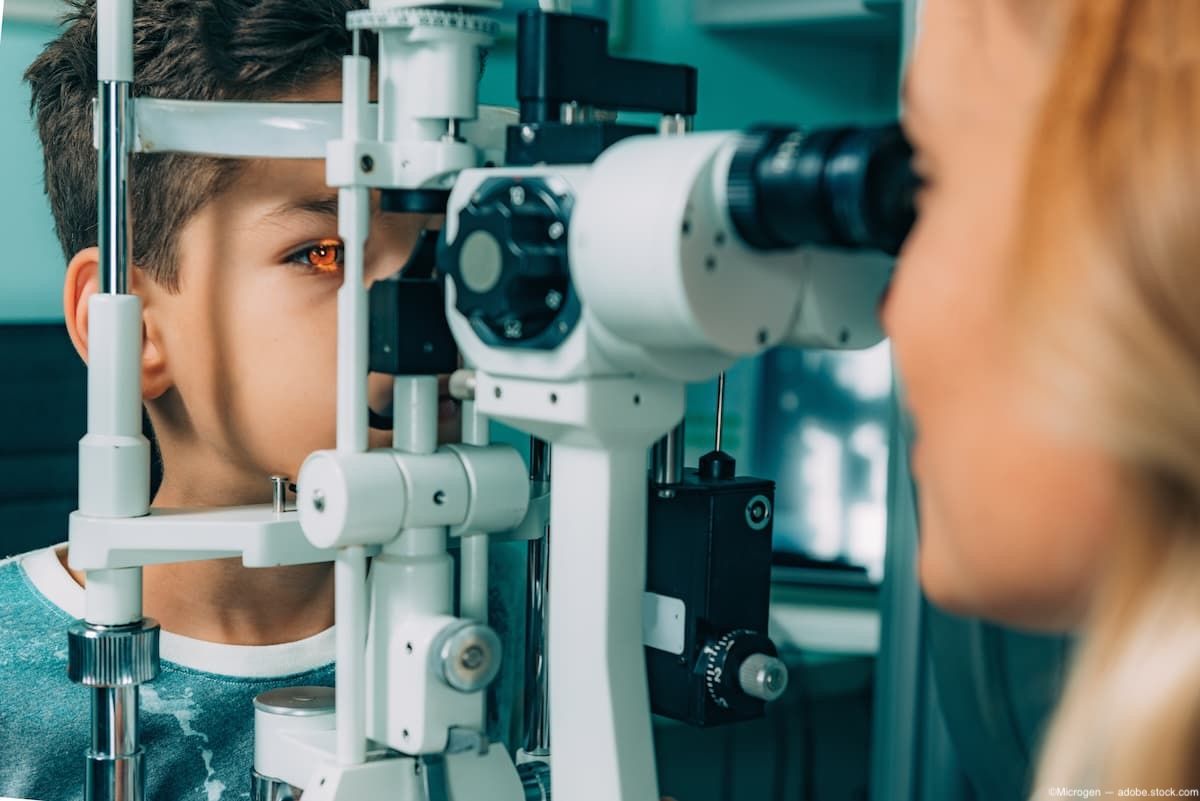(Image credit: AdobeStock/Microgen)
Zhehuan Zhang, MD, and colleagues from the Department of Ophthalmology, Children’s Hospital of Fudan University, National Children’s Medical Center, Shanghai, emphasized the importance of patients undergoing routine optical coherence tomography (OCT) scans during repeated low-level red-light (RLRL) therapy in order to detect retinal changes.
In this study, they noticed axial elongation and spherical equivalent refraction (SER) effects on myopia; however, in those treated with red light, they also found transient foveal RPE hyperreflectivity
The authors published their findings in a research letter in JAMA Ophthalmology.1
Because of the rapidly growing prevalence of myopia around the world, the investigators cited the need to identify safe and clinically effective methods for delaying its onset and managing its progression. Recently, RLRL therapy has been receiving increasing attention as a potential way to control myopia.2,3
They conducted a randomized clinical trial with the goal of assessing efficacy and safety of RLRL therapy for myopia control with emphasis on changes seen in OCT images.
The participants underwent comprehensive ophthalmologic examinations and personalized professional consultations with ophthalmologists. The axial length was measured using an IOLMaster ocular biometer (Zeiss).
The study included 86 children (48% female) aged 7 to 12 years who had refractions that ranged from −1.00 diopters (D) and +1.00 D (inclusive) in both eyes and astigmatism less than 1.50 D. The children were randomly assigned to the red light treatment group or to the control group; both groups included 43 children each.
The children in the active treatment group received twice-daily RLRL therapy using a 650-nm desktop device, Eyerising Myopia Management device (Eyerising International). The parents supervised the administered of the treatments. All patients underwent follow-up evaluations at 1, 3, and 6 months after baseline.
The mean (SD) best-corrected visual acuities (BCVAs) in the RLRL group and the control groups, respectively, were 0.001 (0.008) logarithm of the minimum angle of resolution (logMAR) (Snellen equivalent, 20/20) and 0.004 (0.013) (Snellen equivalent, 20/20). The respective mean (SD) axial lengths were 23.68 (0.64) mm and 23.75 (0.64) mm. The mean (SD) SERs were −0.22 (0.58) D and −0.01 (0.51) D.
At the 6-month examination, 35 children (81%) in the RLRL group and 34 (79%) in the control group completed the follow-up.
The investigators reported, “The axial elongation increased by 0.05 mm in the RLRL group and 0.25 mm in the control group (between-group difference, 0.20 mm; 95% confidence interval [CI], 0.11 to 0.28 mm; P <0 .001). The SER progression was −0.20 D in the RLRL group and −0.61 D in the control group (between-group difference, −0.40 D; 95% CI, −0.62 to −0.19 D; P < 0.001).”
They also found that the BCVA changed by −0.001 logMAR in the RLRL group and 0 logMAR in the control group (between-group difference, 0.001 logMAR; 95% CI, −0.008 to 0.005 logMAR; P = 0.67). No severe treatment-associated adverse events occurred.
Three eyes of 3 children (7%; 95% CI, 1%-15%) in the RLRL group were found to have transient dome-shaped hyperreflectivity between the retinal pigment epithelial layer and the foveal ellipsoid zone on OCT (2 eyes at 1 month and 1 eye at 6 months).
None of the children had visual symptoms, and the BCVA was preserved; the fundus examination was normal. The hyperreflectivity resolved completely after the RLRL therapy was stopped in from 0.5 to 3 months without a decreased in the VA.
In discussing their results, Zhang and colleagues, in addition to the axial elongation and SER effects they observed, they cited a previous study by Liu et al.4 who reported visual loss accompanying the retinal changes.
“To our knowledge, this phenomenon has not been reported previously and underscores the potential importance of routine OCT scans during RLRL therapy for detection of retinal changes,” they emphasized.
References
-
Zhang Z, Hu D, Xu W, Wu T, Gao L, Yang C. Structural OCT changes following repeated low-level red-light therapy for myopia prevention. JAMA Ophthalmol. Published online August 21, 2025. doi:10.1001/jamaophthalmol.2025.2767
-
Jiang Y, Zhu Z, Tan X, et al. Effect of repeated low-level red-light therapy for myopia control in children: a multicenter randomized controlled trial. Ophthalmology. 2022;129:509-519. doi:10.1016/j.ophtha.2021.11.023
-
Xiong R, Zhu Z, Jiang Y, et al. Longitudinal changes and predictive value of choroidal thickness for myopia control after repeated low-level red-light therapy. Ophthalmology. 2023;130:286-296. doi:10.1016/j.ophtha.2022.10.002
-
Liu H, Yang Y, Guo J, Peng J, Zhao P. Retinal damage after repeated low-level red-light laser exposure. JAMA Ophthalmol. 2023;141:693-695. doi:10.1001/jamaophthalmol.2023.1548
